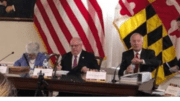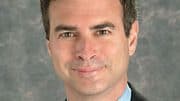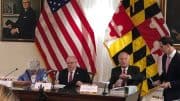Peter Franchot shared “incredible news” Tuesday that he’s the “number one” choice among Baltimore area voters.
According to what poll?
“According to a recent survey conducted last week,” conducted by the Franchot campaign, of course!
“I am the number one choice for Governor among Baltimore area voters,” Mr. Franchot said in his Dec. 21 email blast.
“An overwhelming 73% of those surveyed said they would vote for me if the Democratic primary were to end today.”
That settles it.
Grab the noisemakers and order your Carvel cakes!
It’s time to party, for Baltimore-area residents have spoken – and it’s Peter Franchot they’ve chosen!
All 73% of them.
But first, a brief review of Mr. Franchot’s polling data, then the coronation parade takes off on Route 50 at 7:00 p.m.
Breaking Down Peter Franchot’s Latest Polling Update
Let’s take a look at Peter Franchot’s latest survey results.
Hold on, just for a moment, while A Miner Detail’s crank team explores Mr. Franchot’s polling variables.
(Searching.)
Please enjoy the dancing penguin while we confirm the results of Mr. Franchot’s “major polling update.”

There’s a slight problem.
Mr. Franchot’s campaign email blast failed to attach the corresponding survey data it used when conducting its poll.
Why not?
Because it’s not real.
How Much More Embarrassment Can Peter Franchot Suffer?
A leading gubernatorial candidate is reduced to quoting unnamed, unknown, and unscientific “surveys,” clinging to the long-expired notion of inevitability?
Ben Smith, the Maryland Democratic Party’s former executive director, manages Mr. Franchot’s campaign.
Does Smith read the campaign’s content before it hits inboxes, assuming he isn’t too busy unregistering Mr. Franchot from upcoming gubernatorial forums?
Judging from the outside, it seems like the Franchot campaign has vetting problems.
(See Monique Anderson-Walker.)
Doesn’t it feel like Mr. Franchot is already the Hillary Clinton of this Maryland Democratic gubernatorial cycle?
(All due respect to Secretary Clinton.)
How To Examine A Political Poll’s Credibility
The guidelines below reflect the tenets of AAPOR’s Transparency Initiative and are presented (and paraphrased) by APM Research Lab’s managing partner, Craig Helmstetter.
Who Funded The Poll?
Advocacy groups and those affiliated with campaigns are heavily invested in their polling outcomes.
News organizations may ignore campaign polling results or write about them only after scrutinizing the results at great length.
You’ll want to learn who or what funded a political poll to understand the funders’ intent and motivations.
What/Who Is The Target Population?
Political polls may focus on the voting-age population, likely voters, or registered voters.
The information collected may be valid but can yield different results.
What Sampling Methods Are Used To Collect Data?
Political polls that rely only on landlines no longer cut it.
Similarly, internet-based polls relying exclusively on people who opt-in are equally unreliable.
Are The Polling Results Weighted?
It’s likely impossible to collect a sample that perfectly reflects a poll’s target population, no matter how credible the sampling methods are.
Mathematical adjustments are made after the fact to make the poll as accurate as possible.
For example, if 18-to-34-year-olds are only 5 percent of respondents but are 20 percent of the population, adjustments are made to account for the change.
Pay Close Attention To The Polling Questions
A credible survey should access the original questions and the primary “topline” results.





